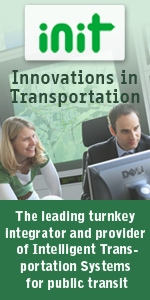

| In This Issue |
| » BREAKING NEWS |
| » NEWS HEADLINES |
| » IN DEPTH: TECHNOLOGY |
| » APTA NEWS |
| » TELLING OUR STORY |
| » COMMENTARY |
| » PEOPLE ON THE MOVE |

Check out the classifieds for numerous transit career opportunities including a chief executive officer!
| IN DEPTH: TECHNOLOGY |
UV-Based System Reduces HVAC Pollutants in Transit Vehicles
By JOHN R. BELL, APTA Program Manager-Communications
Supreme Court Justice Louis Brandeis famously said, “Sunlight is the best disinfectant.”
He probably didn’t mean that literally. But a new product being used on public transit buses and paratransit vehicles harnesses a key element of sunlight to keep air-conditioning units cleaner, offering a healthier environment for both passengers and operators and saving transit systems time and money.
The new system uses the C spectrum of ultraviolet (UV) light to kill viruses, bacteria, and mold spores, all of which normally collect on air conditioner condensers, requiring costly, labor-intensive regular cleaning with chemicals—until now.
Ultraviolet Germicidal Irradiation (UVGI) was developed in the 19th century. In 1903, a physician received the Nobel Prize for using the process to prevent the spread of tuberculosis. UV lamps are now used to treat jaundice in newborn infants; the light helps break down the excess bilirubin in the infants’ blood. Many large cities use UV light to kill pathogens in their water supply, and the food industry uses it to eliminate such pathogens as salmonella.
The UV product for public transportation comes from Lee Huston of Florida and his business, JKA Company. Huston began with a grant from the Transportation Research Board’s Transit Innovations Deserving Exploratory Analysis (IDEA) Program; his final report was published by the Transit Cooperative Research Program as Project 53.
The JKA system uses bulbs by California-based Steril Aire, which holds several patents that make it the only producer of such bulbs.
The technology “allows the UV lamps to not only kill all the pathogens that pass over it, but it has a major energy savings,” said Huston. “The UV lamps at the evaporator keep all the biofilm (mold, fungi, etc.) from forming on the evaporator fins.”
Biofilms, he explained, reduce efficiency in heat exchange; thus, keeping the evaporators clean saves up to 20 percent on energy use. “In transit it means less fuel is used, approximately one-half gallon per day (10-hour day) per bus,” he said.
JKA has also developed a new, reusable electrostatic air filter to be used with the UV lamps that changes the way evaporators are cleaned. “The old filters allowed large particles to clog up the evaporators, which just means more cleaning and labor,” he said. “Now the evaporator is vacuumed off in 5 minutes and the filter washed in 5 minutes and replaced in 5 minutes—15 minutes on a job that before took up to one hour.”
Previously, chemicals were used to clean evaporators. However, these can pose safety risks to maintenance staff and to the environment, Huston said, while using only water avoids such risks and actually helps the fungi in the biofilm to grow.
Huston noted that his system can save transit systems money. The new filter costs $92 and lasts for five years, for a cost of $18.40 per year, according to his IDEA Program report. This contrasts with approximately $120 per year per bus for disposable filters.
Houston’s Metropolitan Transit Authority of Harris County was the first transit agency to use the JKA system; Florida recently announced that it has made UVGI mandatory in all paratransit buses.
Jon Kavaliunas—maintenance manager for Palm Tran in West Palm Beach, FL, which has installed the JKA units on 30 buses in its fleet—said he has noticed “a big difference in the cleanliness of our a/c coils. A lot of times, you’d see dust and dirt on them between major a/c [preventive maintenance servicings].” With the UVGI bulbs, “the coils are nice and shiny, like they’re brand new.” This is seen as contributing to fuel savings over the long term, given that the clean compressors will not use as much energy.
But the most immediate benefit is in saved labor. Palm Tran conducts a preventive maintenance servicing every 60 days; the process previously involved using chemicals to clean the coils. But since installing UVGI, “We’re cleaning coils twice a year or as needed,” Kavaliunas said. “It’s rare that we have to do anything more than hose them off.”
Using water instead of chemicals is not only safer and greener, it doesn’t pose the possibility of any lingering odors that chemicals can produce, so passengers and operators “don’t really know it’s there,” he said.
The system has been dependable so far, Kavaliunas said, adding: “We haven’t had to replace bulbs or ballasts. It’s been a reliable system.”
Additional information on the system can be found in issue 14 (Fall/Winter 2008) of the TRB publication Ignition. The IDEA 53 final report is available here.
| « Previous Article | Return to Top | Return to Main | Next Article » |
|
||||||
| AMERICAN PUBLIC TRANSPORTATION ASSOCIATION |
Telephone (202) 496-4800 • Fax (202) 496-4321
Search Back Issues